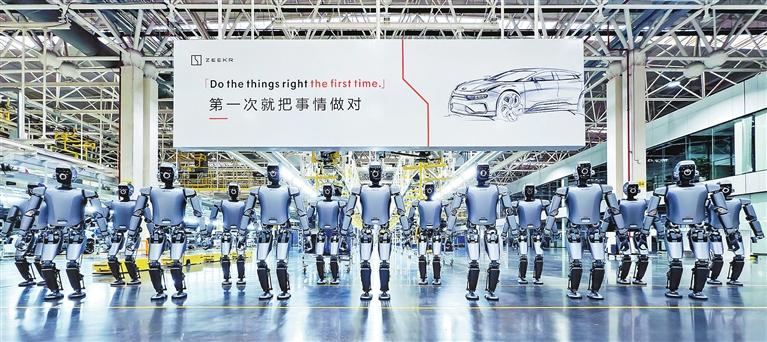
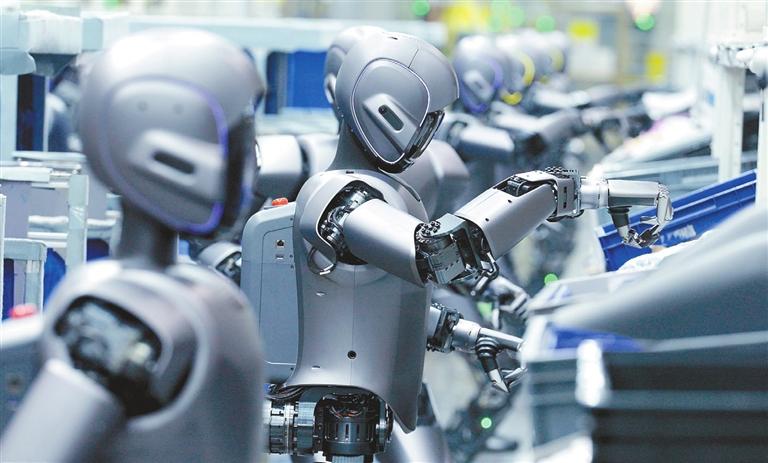
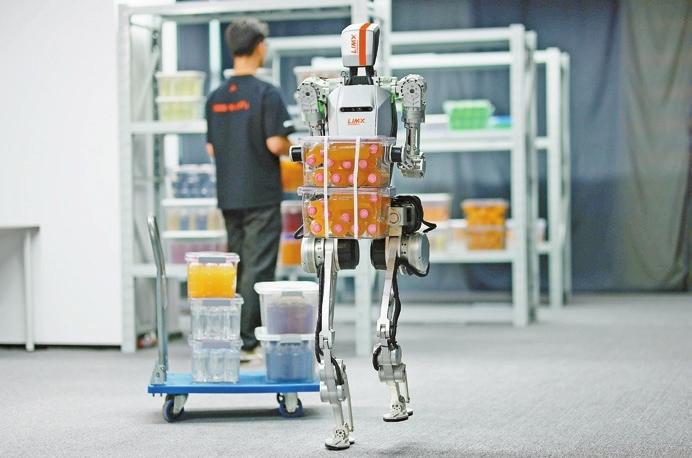
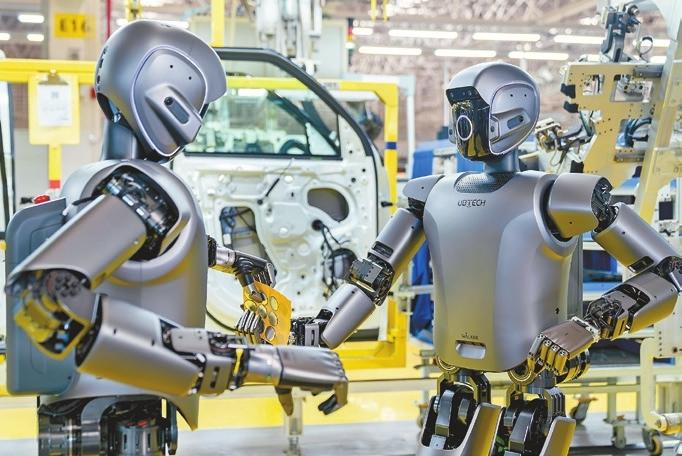
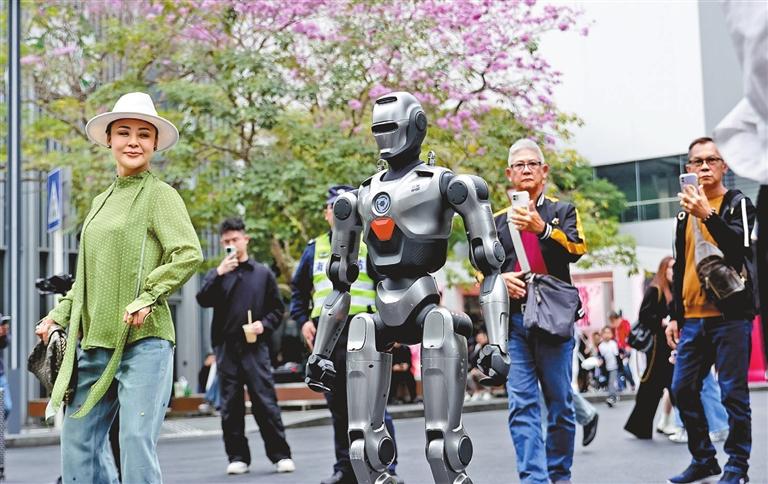
Zhang Yu JeniZhang13@163.com WHILE the stunning front flip performed by EngineAI was still making a splash online, another Shenzhen humanoid robotics company dropped a bombshell March 3 with a short video straight out of a science fiction film: UBTECH’s Walker S1 humanoid robots were seen working in unison across a variety of complex industrial tasks and scenarios inside a car factory. Shenzhen, at the heart of China’s technological frontier, is making a bold play to become the global epicenter of artificial intelligence (AI) and robotics. On the heels of three plans released March 2 to optimize the business environment, Shenzhen unveiled four action plans the following day, aiming for an unprecedented surge in the AI and robotics sectors. Specifically, two action plans were related to AI, one to embodied AI robotics, and one to supporting young, fast-growing startups. In the race to dominate the emerging fields of AI and robotics, Shenzhen —known as China’s Silicon Valley — has notably quickened its pace, positioning itself as a frontrunner in this high-stakes technological sprint. AI testing ground Earlier this year, Chinese AI firm DeepSeek shook the global AI industry with its low-cost, open-source large language models (LLMs). The U.K.’s Financial Times likens DeepSeek’s founder Liang Wenfeng to a David taking on the Goliath of America’s big tech giants. Shenzhen is swiftly embracing DeepSeek by integrating it into the very fabric of the city’s digital landscape. One by one, government agencies, public institutions, hospitals, and various other entities have successfully adopted DeepSeek across their operations. Fan Congming, executive president of the Shenzhen Artificial Intelligence Industry Association, emphasized that 2025 is a pivotal year for AI development. “Shenzhen is poised to capitalize on the convergence of ‘AI industrialization and industrial AI,’ harnessing comprehensive applications across all domains, at all times, and in all scenarios to propel industrial growth,” Fan said. Lin Yi, deputy director-general of the city’s industry and information technology bureau and director of the Shenzhen Artificial Intelligence Industry Office, said that Shenzhen has made an early start and laid a solid foundation in the realm of AI. Lin further explained that the city has assembled a dedicated industrial team and established the Shenzhen Artificial Intelligence Industry Office, ensuring that industrial development is spearheaded by a professional, competent team. Meanwhile, the city is home to over 2,600 AI companies, including six unicorns. More than that, Shenzhen has set its sights on transforming the entire city into a testing ground for AI. From broadening the scope of AI applications to fueling growth across diverse industries, and from enhancing innovation capabilities to attracting young professionals, the goals are ambitious and all-encompassing. According to the city’s 2025-2026 action plan for accelerating the development of the AI terminal industry, Shenzhen aims to grow its AI terminal industry to a scale of over 800 billion yuan (US$110.43 billion) by 2026, with an ambitious target of reaching 1 trillion yuan. It also endeavors to have at least 10 high-impact AI terminal enterprises, produce over 150 million AI terminal products, and launch more than 50 popular AI products across various fields such as mobile phones, computers, integrated large model machines, and wearable devices. In addition, Shenzhen aspires to construct more than 60 quintessential application scenarios for AI terminals, spanning a wide array of fields. These include intelligent manufacturing, using AI to streamline and enhance production processes; smart finance, leveraging AI for more accurate, efficient financial services; smart cities, using AI to improve urban management and residents’ quality of life; smart elder care, employing AI to provide personalized, responsive care for the aging population; and smart government, integrating AI to optimize administrative functions and public services. In the 2025-2026 action plan for accelerating the development of a pioneer city in AI, it is projected that by 2026, Shenzhen will have over 3,000 AI companies, including over 10 unicorns. Meanwhile, the AI industry is expected to experience an impressive average annual growth rate of over 20%. To further catalyze this growth, Shenzhen will establish over 10 innovation incubators for AI and embodied AI robotics. Upping the ante in robotics The robotics race is every bit as intense and competitive as the global AI race. As countries and cities vie for technological supremacy, robotics stands as a pivotal field with the potential to revolutionize industries, automate tasks, and enhance people’s quality of life. With rising stars like Unitree making waves in the robotics industry, many are also watching to see if Shenzhen and its tech giants can deliver on the promise of humanoid robots that are not just technologically impressive but also economically viable and ethically responsible. In fact, Shenzhen has already gathered several competitive robotics companies. Seven local firms — BYD, Tencent, UBTECH, RoboSense, Leadshine, ZHAOWEI, and Inovance — have entered Morgan Stanley’s “Humanoid 100: Mapping the Humanoid Robot Value Chain,” a comprehensive list of global companies poised to benefit from the growth of humanoid robots. In addition to UBTECH, other notable local humanoid robotics companies such as Leju Robot, EngineAI, and LimX Dynamics are also gaining significant traction and continuing to secure substantial investments from discerning investors. The numbers speak for themselves. Shenzhen has over 57,000 robotics-related enterprises, ranking first in Guangdong Province. The city also has 34 publicly traded robotics companies, including nine unicorns. However, Shenzhen is clearly asking for more. As outlined in its 2025-2027 action plan for technological innovation and industrial development of embodied AI robotics, breakthroughs are anticipated in key areas such as robot core components, AI chips, AI-robotics integration, multimodal perception technologies, high-precision motion control, and dexterous manipulation technologies. The city aims to cultivate more than 10 companies valued at over 10 billion yuan each and over 20 companies with revenue exceeding 1 billion yuan each by 2027, with the number of enterprises in the embodied AI robotics industry cluster expected to surpass 1,200. Shenzhen’s tech giants are also riding the waves of the embodied AI robotics sector. BYD’s embodied AI research team has developed products such as intelligent collaborative robots and intelligent mobile robots. Last November, the Huawei (Shenzhen) Global Embodied AI Industry Innovation Center began operations and signed cooperation agreements with 16 embodied AI-related companies. All eyes on Shenzhen “Behind the array of robust policies introduced by Shenzhen lies a profound determination to take the helm in the era of AI 2.0,” said Wu Haifeng, director of the Sustainable Finance Research Center at The Chinese University of Hong Kong, Shenzhen. To secure a competitive edge in the latest round of the global tech contest, Shenzhen must go beyond merely enacting policy measures and delve into a more comprehensive strategy, according to industry insiders. After all, talented individuals, investment capital, and innovative enterprises naturally gravitate towards environments conducive to growth. Whether Shenzhen, a long-time tech powerhouse in China, will succeed in the high-stakes AI and robotics race is a question that only time can answer. | 
